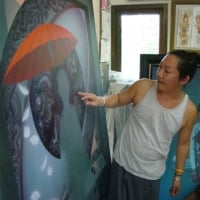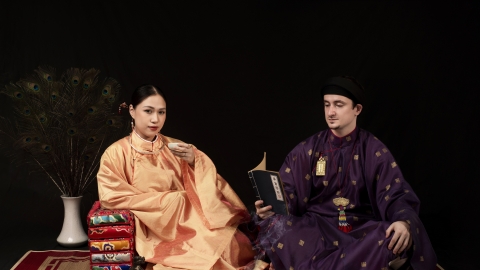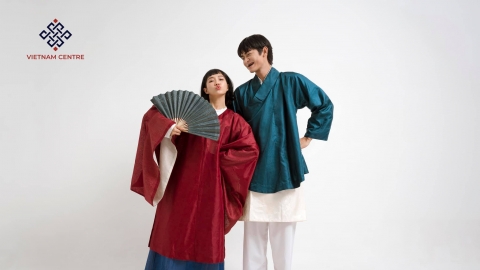Combining passion for traditional costumes and dyeing fabrics with natural materials
When it comes to traditional costumes, 9x Nguyen Duc Huy is a familiar name in the industry. His love for Vietnamese traditional costumes began when he went to study abroad in Germany in 2015, when he was often asked by foreign friends what traditional Vietnamese costumes consisted of. Realizing that he did not know much about Vietnamese culture, he began to learn. During that time, the movement to restore traditional costumes in Vietnam gradually developed, so Huy was exposed to Vietnamese traditional costumes. Fascinated by the beautiful and diverse traditional Vietnamese costumes, Duc Huy decided to embark on the field of restoring Vietnamese traditional costumes when he returned home in 2018.
Regarding his passion for dyeing fabrics, Duc Huy said he loves handicrafts and green living, so he often makes his own items. This lifestyle also includes dyeing fabrics and old clothes.

Huy is often asked by foreigners what traditional Vietnamese costumes include?
From attending a workshop, he started experimenting with indigo dyeing old clothes at home. At first, it was just a hobby, but he soon realized that natural dyeing could complement his research and making of traditional costumes, so he decided to combine the two and create traditional costumes made with naturally dyed fabrics.
Research, learn and be passionate
To learn more about natural dyeing, Duc Huy went to Sapa for a month and a half to learn indigo dyeing from the Mong people, or learn from the Dao, Thai people and his predecessors. Then he learned more about Japanese and Chinese dyeing methods through online documents. However, learning and learning through online documents is not systematic, nor does it have a ratio, so Duc Huy had to experiment and explore quite a lot. Besides, natural dyeing is closely related to local characteristics. Each region has different flora. Not all types of plants in China and Japan are available in Vietnam. So Duc Huy had to find alternative materials to dye similar colors.

Natural dyeing is closely related to indigenousness.
In studying ancient costumes, ancient costume documents often do not specify the color of the costume, but some do state what materials the fabric is dyed from. Through the practice of dyeing fabric, Duc Huy understands more about the colors and tones of ancient costumes to further complete his research. Currently, Duc Huy spends most of his time researching and sewing ancient costumes such as Ao Nhat Binh, Ao Tac, Ao Giao Linh, Vien Linh, and Doi Kham.
Diverse fabric dyeing materials
The materials that Duc Huy uses to dye fabrics are natural materials, the most common of which is traditional Chinese medicine. He said that this is a dry material that can be used all year round and can be easily found in traditional Chinese medicine stores. In addition, he has also experimented with other natural materials such as brown tubers, sappanwood, almond leaves, chrysanthemums, safflowers, marigolds or tea leaves, guava. However, using fresh materials such as flowers or leaves is more expensive and harder to find, so he always prioritizes dry materials.

Fabric dyeing materials are extremely diverse.

He also experimented with different natural ingredients.
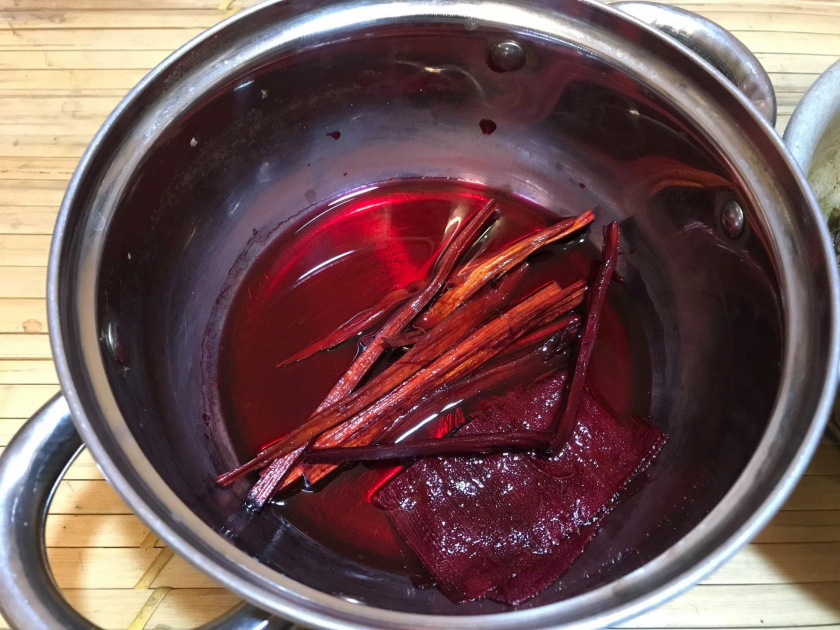
He also experimented with different natural ingredients.
The elaborate fabric dyeing process
The process of dyeing fabric usually goes through the basic steps: the raw materials are put into water, boiled for about 30 minutes. When the boiled water reaches a certain color, it is poured into a basin with a little cold water. The fabric will then be put into the basin, soaked for 10 to 15 minutes. After absorbing the color, the fabric is put on a wooden or plastic bar to dry.
However, there are some more complicated materials, for example, indigo will have to go through a fermentation process to dye or some materials must be soaked in alcohol to get the color. Natural dye tones are more complicated than industrial dyeing because to get a dark color, you have to dye many times to overlap the color. Sometimes natural dyers have to dye dozens to hundreds of times to get a dark color. When drying, naturally dyed fabrics must also be dried in the shade.
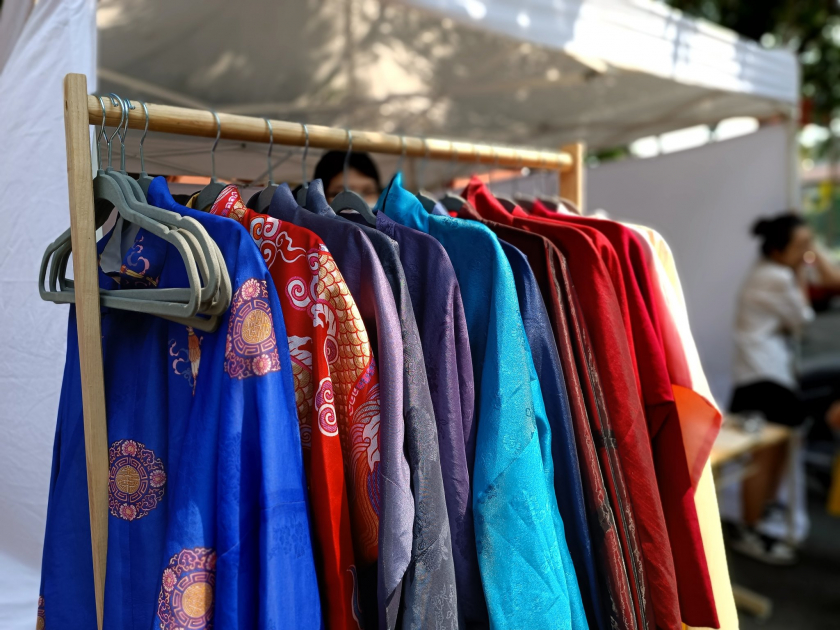
Sometimes natural dyers have to dye dozens to hundreds of times to get a dark color.
Dyeing time will take about 2-3 weeks depending on the color intensity. After many experiments and failures, Duc Huy has found more than 50 colors from natural dyes.
A fabric is considered to be successfully dyed by the color fastness of the fabric. After dyeing, if the fabric does not fade when washed or if it is exposed to light and does not fade or fades very slowly, then the fabric is considered to be successfully dyed.
Currently, he is mainly dyeing on silk because this material is suitable for sewing traditional costumes, and silk dyeing also creates products with higher brightness than cotton or other fabrics.
Young people are interested in traditional costumes
Duc Huy said that at the end of the year or on holidays, people will order traditional costumes a lot because of the trend of wearing traditional costumes to take photos. However, traditional costumes are often more popular with young people, while traditional costumes dyed from natural materials are for people aged 25 and older.
It takes more effort and materials, so currently the naturally dyed products at Duc Huy's store are 2-3 times more expensive than industrial or food dyed products, from 3 to 6 million. Traditional costumes made of naturally dyed fabric are also quite picky about buyers, a month he receives 2-3 orders for traditional costumes made of naturally dyed fabric, while traditional costumes made of other fabrics can be from 10-20 orders.

Traditional costumes are increasingly popular among young people.
Plan to develop traditional costumes made of naturally dyed fabrics
Determining this as his long-term and serious path, Duc Huy wishes to continue researching many colors created from natural materials. He also wishes to diversify many types of fabric to make traditional costumes from domestic sources, creating patterns on the fabric when dyeing instead of plain dyeing as at present. Besides, Duc Huy will also research more deeply Vietnamese fabric materials to create new sources of fabric, applying in natural dyeing.








